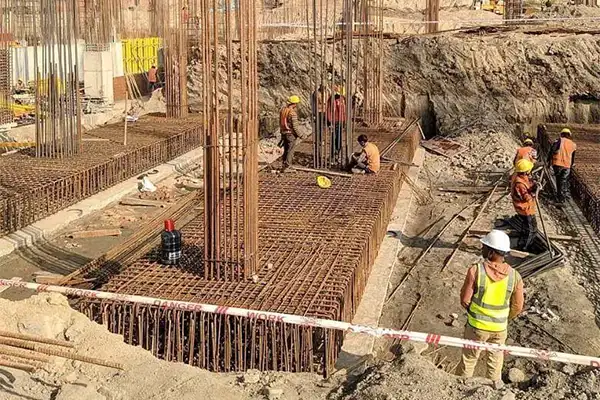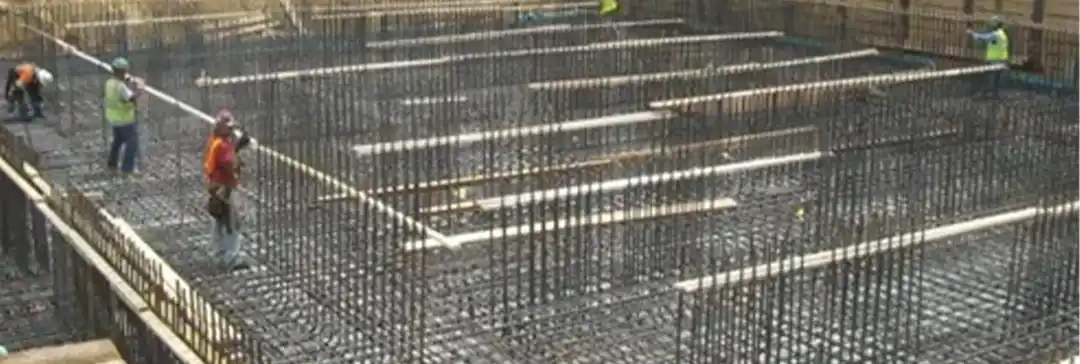In the world of construction, the foundation is like the strong base of a house, quietly supporting the whole structure and ensuring its weight is spread evenly on the solid ground below. Generally, there are two kinds of foundations: shallow and deep.
Shallow foundations, also called spread footings, are used when the ground near the surface is strong. There are different types of shallow foundations, such as isolated footings (for one column), combined footings (for multiple columns), and mat foundations (covering the whole building area).
Selecting the proper foundation is similar to selecting the perfect structural support for a building. Its selection is based on the weight of the structure, the conditions of the ground, and the particular construction requirements. A building’s long-term durability depends on the choice of foundation.
In shallow foundations, Combined footing is an excellent choice, especially in cities with columns close together.
This blog gives detailed information about combined footing, its types, suitability, advantages, and disadvantages of combined footing.
So, let’s start the journey …
What is Combined Footing?
Combined footings are made when two or more columns are sufficiently close to one another and their isolated footings overlap. They are a combination of isolated footings, but their structural layouts differ.
The shape of the combined footing is a rectangle. It is used when the columns carry loads from the structure.
Combined footings are a great option, particularly in cities where columns are close to one another. They’re excellent for providing even support and stability, but it’s important to consider the unique soil and climate conditions in India. Experts from Brick&Bolt should be involved in planning and designing combined footing for the best results in India’s diverse needs.
Types of Combined Footing
Combined footings come in various forms, and they are categorised according to how they are shaped and how the columns they support are arranged.
The primary categories of combined footings are:
- Rectangular Combined Footing
- Trapezoidal Combined Footing
- Strap Combined Footing
- Raft Combined Footing
Rectangular Combined Footing
They have a rectangular shape and are strong enough to support two or more columns at once. Anywhere a rectangular form and the capacity to support equal weights are required, a rectangular combined footing is employed.
Trapezoidal Combined Footing
Trapezoidal footing is used when one column load is significantly greater than the other. Therefore, a trapezoidal combined footing is needed when there is a limited amount of space outside the external column, and the exterior column is heavier.
Strap Combined Footing
Strap combined Footing is a kind of combined footing made out of a concrete beam connecting two or more column footings. The term “strap beam” refers to this kind of beam. It assists in distributing the weight of column footings that are eccentrically or highly laden to neighbouring footings.
Raft Combined Footing
Raft footing is a kind of combined footing that supports all the walls and columns and covers the full area underneath the construction.
Suitability of Combined Footing
Combined footings are suitable when two or more columns are closely spaced, and individual footings for each column would overlap or interfere with each other.
The suitability of combined footings is influenced by several factors, including:
- Closely Spaced Columns: Combined footings are well-suited for situations where columns are closely positioned, making it impractical to have separate footings without significant overlap.
- Unequal Column Loads: When columns bear uneven loads, combined footings provide an effective solution to distribute these varying loads and prevent issues like differential settlement.
- Limited Soil Bearing Capacity: Combined footings efficiently utilise available soil support for multiple columns in cases with limited soil bearing capacity.
- Economic Design:Combined footings can offer cost-effective solutions, especially when dealing with closely spaced columns, compared to providing individual footings for each column.
- Structural Considerations: The design of combined footings is influenced by the structural requirements of the building and the specific loads on the columns. The combined footing’s plan shape might be trapezoidal, rectangular, or tee-shaped. The centroid of the footing area coincides with the column loads because the geometric proportions and shape are fixed. As a result, the pressure beneath the whole footing is consistent.
- Soil Characteristics: The suitability of combined footings also depends on soil characteristics, including bearing capacity and the potential for differential settlement.
- Architectural Constraints: Architectural and layout constraints may lead to combined footings, especially when the building design necessitates closely spaced columns.

Advantages of Combined Footing
Combined footings provide several advantages in structural engineering and construction, particularly in scenarios involving closely spaced columns.
The key benefits of combined footings include:
Effective Load Distribution:
It efficiently distributes loads from multiple columns, preventing issues associated with uneven settlement and ensuring consistent support.
Optimised Space Utilization:
Combined footing maximises the use of space, especially in situations where closely spaced columns would make individual footings impractical due to overlap.
Cost-Effective Design:
It is cost-effective compared to the alternative of providing individual footings for each column, particularly in cases of closely spaced columns.
Optimisation of Soil Bearing Capacity:
Overcomes limits in soil strength by effectively utilising the available soil-bearing capacity to sustain many columns.
Structural Flexibility:
Offers flexibility in design, allowing engineers to choose from different types of combined footings (such as rectangular or trapezoidal) based on specific structural requirements.
Architectural Freedom:
Provides freedom in layout design, accommodating closely spaced columns without compromising the foundation’s integrity.
Efficiency in Foundation Design:
Streamlines the construction process, as combined footings simplify foundation design and construction for projects with closely spaced columns.
Enhanced Structural Stability:
Enhances structural stability through the interconnected nature of the footing, providing additional support and resistance against settlement.
Disadvantages of Combined Footing
Combined footings, while offering various advantages, also have certain disadvantages that should be considered in the design and construction process.
Here are the key disadvantages of combined footings:
Complex Design:
The design intricacies of combined footings can surpass those of individual footings, particularly when addressing factors such as uneven column loads, soil characteristics, and architectural constraints.
Limited Load-Bearing Capacity:
Combined footings may have constraints regarding the maximum load they can support. Alternative foundation types are more suitable for heavy loads or larger structures.
Time Consuming Construction:
The construction of combined footings can be more demanding and time-consuming than individual footings, especially when confronted with intricate designs or specific site conditions.
Challenges in Alterations:
Making changes to the building or its structure when using combined footings can be complex, which can make remodelling or altering the layout of the building more difficult.
Not Ideal for Tall Structures:
The relatively small size of combined footings may need adequate support for tall or high-rise structures, potentially leading to settlement or tilting issues.
Site-Specific Challenges:
The suitability of combined footings may be influenced by site-specific challenges, encompassing environmental factors and potential changes in soil conditions over time.
Conclusion
combined footings are a foundation solution for projects with closely spaced columns, requiring efficient use of space and stable support in challenging soil conditions. In situations where columns are closely spaced, they provide effective load distribution, space utilization, and cost-effectiveness; however, one should consider their complex design, limited load-bearing capacity, and difficulties in making changes.
When choosing combined footings, it’s important to carefully look at what the project specifically needs, the condition of the ground, and the building’s structural requirements.
Engineers must weigh the advantages and disadvantages and modify their designs to fit the particular requirements of each construction scenario. In the end, making well-informed decisions guarantees that combined footings are successfully implemented, which adds to the stability and durability of the built structure.

